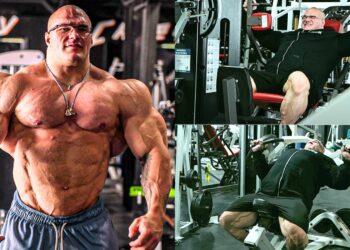Over 40 and want to build more mass? Think that you’re past packing on new muscle? Are your joints a bit sore and battered from all the heavy lifting from the past?
Well, we aren’t twenty-something any longer. We can’t simply do a quick warmup set and jump into heavy lifting like we once did. Things change, we get a bit older, and our lives are thrown in many different directions. Maybe we don’t hold the same goals as we once did. “Big man on campus” was once a thing. An idea we aspired to. We wanted to be bigger, stronger, and more ripped than ever. Peer pressure, competition, and girls were the aims of our efforts. Or maybe we were competitive athletes ever chasing the better personal record, never performing less than our best.
Now that some of that fire is gone we find ourselves a bit left behind. The thought of training is replete with techniques we held close to our egos. Lifting heavy, low reps, driving sets beyond failure, and training through the pain were some of our mantras.
Do we train differently at 40?
It goes without saying that our bodies change as we age. Not only does father time take a toll, but for those of us who have seen the inside of the gym for most of our years, it’s the mileage as well. Achy joints, wrenched shoulders, and banged-up knees are all too familiar maladies. We are quick to talk to others as if our heyday in the gym was some sort of fantastic lore, hard to believe and never to be proven.
So where does this leave us? Do we take up jogging? A “fitness” class to tone up? Golf?
Level Up Your Fitness: Join our 💪 strong community in Fitness Volt Newsletter. Get daily inspiration, expert-backed workouts, nutrition tips, the latest in strength sports, and the support you need to reach your goals. Subscribe for free!
No indeed.
Others of us are still at the old ways of our training, taking the past with us and continuing the heavy weight, low rep dogma as if it would produce similar results as a decade ago. All we get in return are the aforementioned hurt joints and the addition of a bruised ego.
Not all of us are in this boat. Many are still going strong, doing the right things, and taking care of business. For those in that camp, you most-likely haven’t read this far. But for the rest of us who are looking for answers, who are still motivated to press on, and who still want to reshape their physiques and build something great, read on.
Steps for more muscle after 40
Before we delve into a sample program let’s first break down what needs to happen when structuring a program, what needs to change, and how to move forward.
Ego
Ego tends to be a major obstacle for most of us. We were once beasts (in our own heads) when it came to lifting. Who’s to tell us how to put on muscle? We have years upon years of experience. It’s not rocket science, right?
We need to face the fact that our training may need a newer approach, a slightly different perspective. Yes, load in training matters, but so do many other factors. The sooner we accept this the sooner we will be able to have an open mind and learn even more about ourselves.
You’re no longer competing or comparing against twenty-somethings, your only job now is to get better for your own good. To somewhat compete against yourself. As corny as the last line was, it’s true.
Reevaluate goals
Next, let’s piggyback off the last point and reevaluate your physique goals. Is it to compete as a powerlifter, bodybuilder, or armature athlete? Then you’re in the wrong place. Here we want to be as realistic as possible. Evaluate where you currently are in your life, what’s important to you and how to move forward.
A key point here is to have belief. To have faith that your new plan of action will work and be able to be built upon. Your life is possibly filled with responsibility at 40. Job, kids, wife, social life, and any other things that tend to fill our days can be a lot to handle. Inserting a serious training program can potentially feel like another stressor. Not the training itself, but the simple challenge of fitting it into our day.
I am here to tell you it can be done. It just takes some planning and knowhow.
Build a real world program
Again, we’ll keep the ball rolling and build off of each point preceding. Once we have our ego in check and we’ve reevaluated our goals we can now build out a sensible, real world program. Something that is both effective and efficient.
Level Up Your Fitness: Join our 💪 strong community in Fitness Volt Newsletter. Get daily inspiration, expert-backed workouts, nutrition tips, the latest in strength sports, and the support you need to reach your goals. Subscribe for free!
Forget the six days per week schedules and two hours in the gym each day. You’ll need to take into consideration a few things when planning a program. First, how many days per week can you realistically and honestly train? For most of us it would fall somewhere between three and four. Next, how much time do you have each of those days? Maybe 45 minutes or an hour tops? Seems doable right?
As we do want this to be as realistic as possible while factoring in your lifestyle, we also can’t deny that changing our physiques does take commitment and discipline. In other words, a workout routine twice per week, 30 minutes per day just won’t cut it. You’ll need to not only be disciplined with your training but also with your time, your schedule, and other factors such as sleep/recovery, scheduling other commitments, and limiting procrastination and distractions.
Related: Build Your Program: How to Design the Perfect Training Plan.
Monitor progression and regression
It goes without saying that you’ll need to keep track of your training. With all of the life stressors listed above, it’s simply much too easy to skip a day or two if no plan is in place. Keep some type of detailed record of your training. Record exercises, sets, reps, weights lifted, and possibly even the mental state you’re in in case you’ve had a hard day full of stress at work and didn’t have such a great workout.
Keeping track will also give you a much-needed snapshot of what’s working and what isn’t. You’ll easily be able to see strength either increasing or waning and you’ll be able to adjust accordingly. Don’t be afraid to pull back a bit on tough days. Maybe you reduce a set here or there or maybe replace an exercise or two as well. Whatever you need to do to keep going and stay consistent.
Adjust with life
If you’re the type that has the “all or nothing” attitude going in then you won’t make it very long in the lifting game. Burnout will catch up to you and you’ll either end up injured or wanting to quit.
As a bit of an older lifter, you’ll need to pay closer attention to recovery, nutrition, and sleep patterns. Some workouts will simply be maintenance while others will move the needle regarding progress. Keep this in mind and remember that consistency is key. Don’t think of each workout as a knock-it-out-of-the-park training session. Instead look at it as inching your way forward. If something comes up, you miss a workout, or your session sucked that day, don’t fret. Just pick up where you left off the very next time.
The need to lift heavy?
Finally, I mentioned earlier about low rep, heavy weight sets and how they might be a thing of the past. Maybe some of us can still lift heavy, but there are possibly more of us who no longer have the desire and need to find newer and better ways to accomplish the same goals.
Building muscle mass isn’t just reserved for the heavy lifters. Studies have shown the benefits of lighter loads at higher rep ranges building just as much muscle while sparing our joints [1]. Taking muscles to failure seems to be the common factor with regard to hypertrophy [2].
Yes, there are many ways to build muscle, but if heavy lifting is no longer the option for some of us then we do have the same chance at building muscle mass with lighter loads taken to failure.
Example Over 40 Training Program
Below is an example of a typical training week. You’ll be training on a two on one day off, two on two days off format. This can easily work into the week as: Monday, Tuesday, Thursday, Friday with Wednesday and weekends off.
The workouts are divided into an A/B routine where you won’t repeat the same workout in a week’s time. This adds variety and prevents boredom.
Routine A
Monday
- Incline barbell press 2 x 10-15
- Flat dumbbell press 2 x 10-15
- Pec deck 2 x 15
- Wide-grip pull up or pulldown 2 x 10-15
- T-bar or machine row 2 x 10-15
- close -grip pulldown 2 x 15
- Seated dumbbell side lateral raise 2 x 10-15
- Machine shoulder press 2 x 10-15
- Dumbbell shrug 2 x 10-15
Routine A
Tuesday
- Standing calf raise 2 x 10-15
- Seated or lying leg curl 2 x 10-15
- Dumbbell Romanian deadlift 2 x 10
- Leg extension 2 x 20
- Single leg press 2 x 12 each leg
- Barbell back or front squat 2 x 10-12
Routine B
Thursday
- Incline dumbbell press 2 x 10-15
- Dumbbell fly 2 x 15
- Push-up 2 x as many as possible
- Close-grip pull up or pulldown 2 x 10-15
- Bent-over barbell row 2 x 101-5
- Wide-grip pulldown 2 x 15
- Bent-over lateral raise 2 x 15
- Seated dumbbell shoulder press 2 x 10-15
- Barbell shrug 2 x 10-15
Routine B
Friday
- Seated calf raise 2 x 10-15
- Barbell Romanian deadlift 2 x 10
- Seated or lying leg curl 2 x 10-15
- Leg extension 2 x 20
- Walking lunge 2 lengths
- Smith machine squat 2 x 10-12
More related articles:
- Build Bigger, More Muscular Legs After 40
- Can You Get Lean After 40?
- The 5 Changes to Make the Most of Your Training After 40
- Over 40? This is How You Really Should Be Training
In Closing
Training in your 40s isn’t all that different than in your 20s or 30s. We just need to take a few precautions, ditch the ego, make a sound plan, and adjust for life. Building muscle in your 40s is possible, but consistency is key to cranking up the gains once again.
References:
1. Morton RW, Sonne MW, Farias Zuniga A, Mohammad IYZ, Jones A, McGlory C, Keir PJ, Potvin JR, Phillips SM. Muscle fibre activation is unaffected by load and repetition duration when resistance exercise is performed to task failure. J Physiol. 2019 Sep;597(17):4601-4613. doi: 10.1113/JP278056. Epub 2019 Jul 27. PMID: 31294822.
2. Fisher J, Steele J, Smith D. High- and Low-Load Resistance Training: Interpretation and Practical Application of Current Research Findings. Sports Med. 2017 Mar;47(3):393-400. doi: 10.1007/s40279-016-0602-1. PMID: 27480764.












